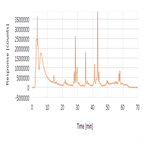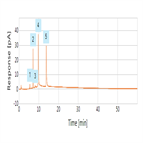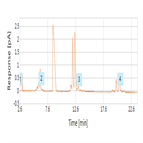Find methods for your needs
Refine by Feature
Displaying 1-4 of 4 results for Tag: glycan profiling
AU206: Improved Separation of Aminobenzamide (2-AB)-Labeled N-glycans from Human α1 Acid-Glycoprotein for Analysis by HPAE-FLD
Instrument Type: ICThis application update demonstrates improved chromatographic separation achieved using a Thermo Scientific™ Dionex™ CarboPac™ PA200 column for the HPAE-FLD method described in proposed United States Pharmacopeia (USP) General Chapter <212> to separate 2-AB-labeled N-linked oligosaccharides from human α1 acid-glycoprotein. An ICS-6000 can be used for this application.
Label-Free Profiling of mAb O-linked Glycans by HPLC with Charged Aerosol Detection
Instrument Type: HPLC-CADO-glycans released by reductive ß-elimination to preserve structural integrity can be quantitatively measured by a simple direct method that minimizes sample manipulation and cleanup. Released glycans are separated with high resolution by charge, size and polarity on a mixed mode column employing both ion exchange and HILIC separation modes, using a simple, mass spectrometry compatible mobile phase.<enter final 90 characters of description>
Label-Free Determination by UHPLC with Charged Aerosol Detection of Glycans Separated by Size, Charge and Isomeric Structure
Instrument Type: UHPLCThis fast and sensitive method is suitable to directly measure the glycan content and profile of glycoproteins. Native N-linked glycans released from proteins by PNGase F are separated on the Thermo Scientific Vanquish UHPLC system by using the Thermo Scientific GlycanPac AXR-1 column. This column employs both weak anion exchange and reversed-phase separation mechanisms to separate glycans based on charge, isomerism and size. The native glycans are quantified directly by using charged aerosol detection.
Glycans by UHPLC-CAD on Thermo Scientific Dionex UltiMate 3000 RSLC
Instrument Type: HPLC-CADGlycans released from bovine fetuin by PNGase-F are separated by gradient elution on the Thermo Scientific Dionex GlycanPac AXR-1 column and detected by charged aerosol detection on the Corona Veo RS.




